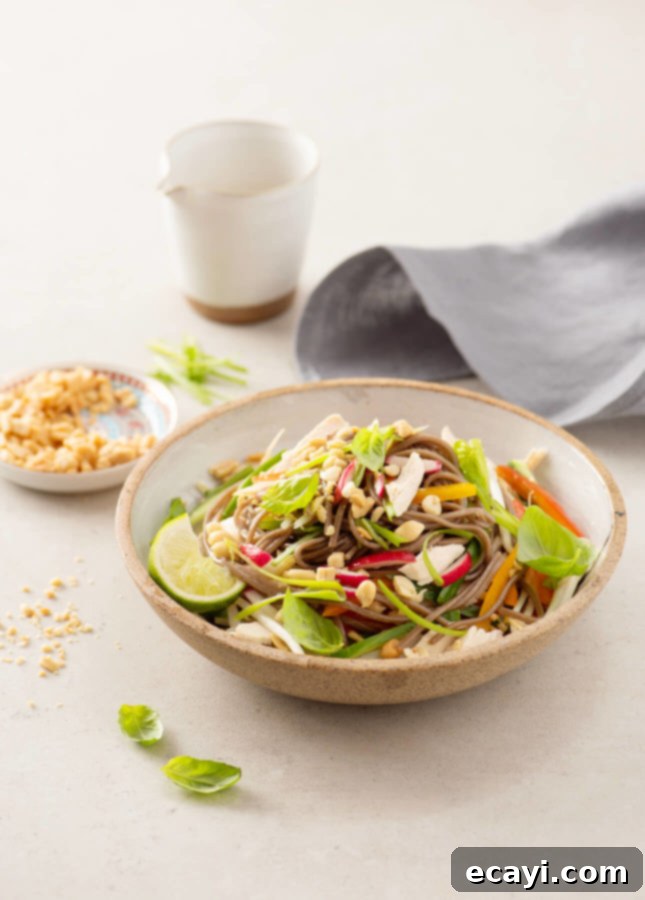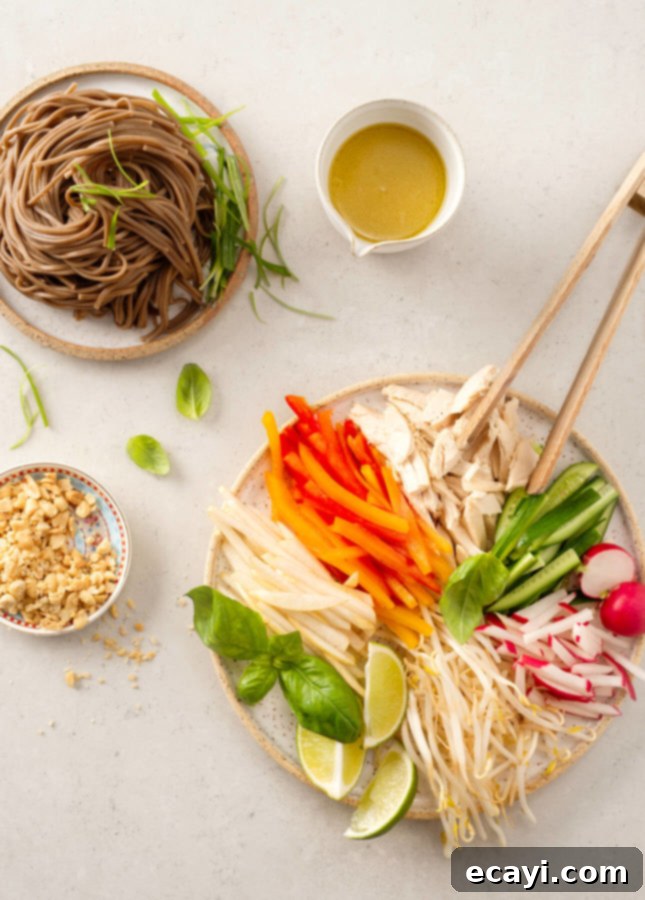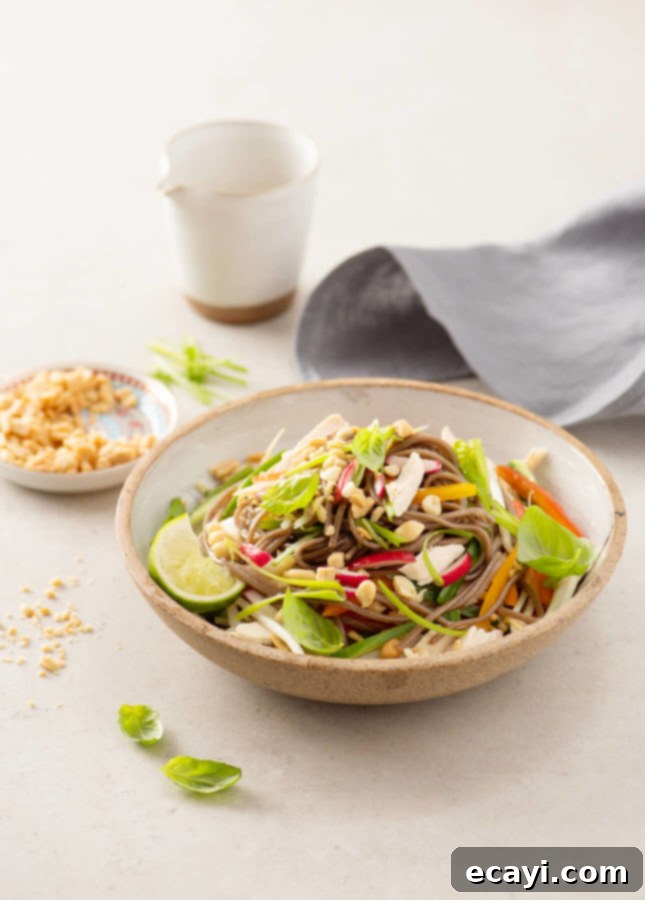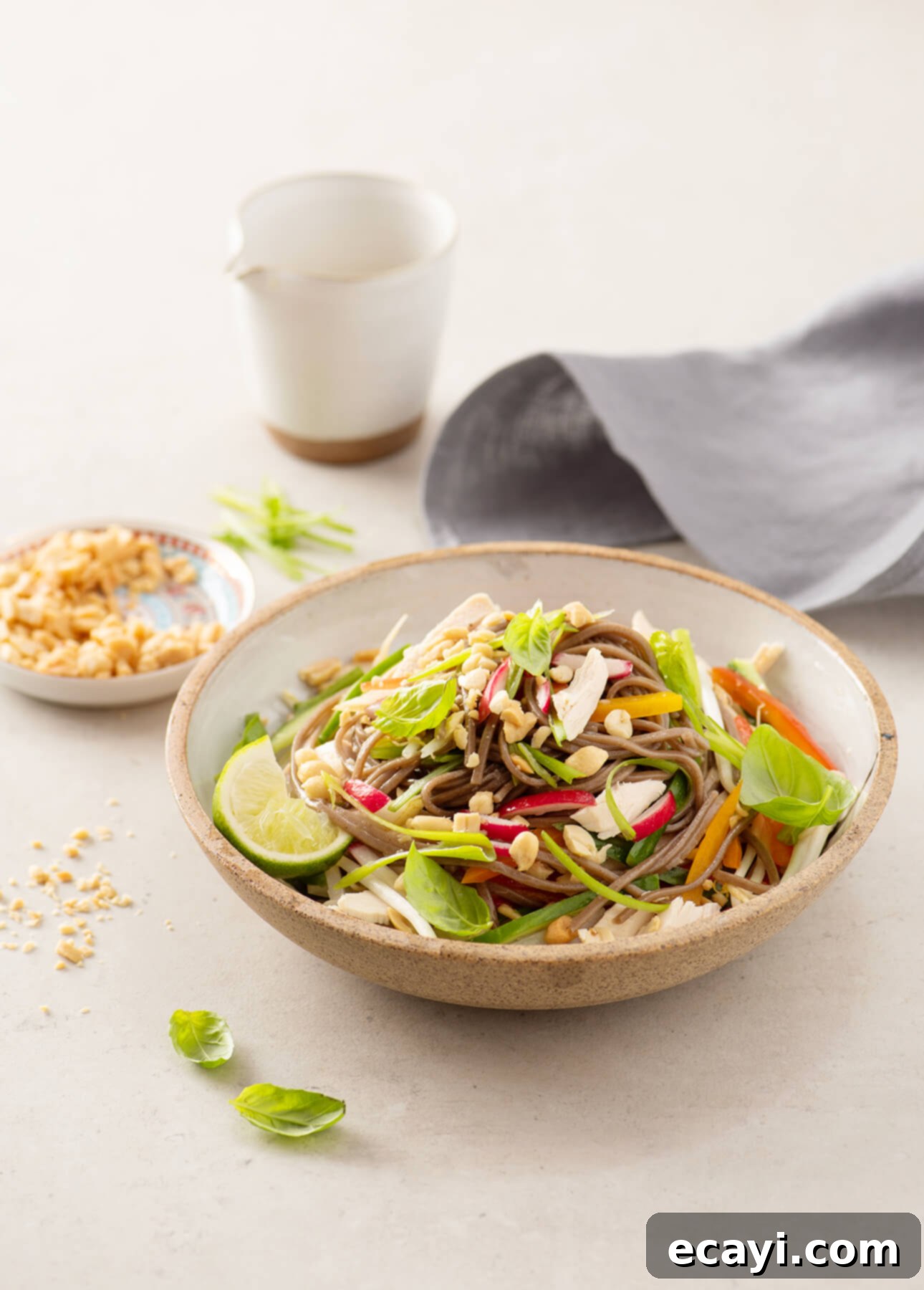The Ultimate Customizable Asian Noodle Salad: Fresh, Flavorful, and Effortlessly Easy
Cooking is often seen as an art, a science, or sometimes, a precise craft requiring meticulous adherence to instructions. While I genuinely appreciate the satisfaction of following a recipe to perfection, I also believe in the power of a good culinary “formula.” A formula offers a framework, guiding principles that empower you to unleash your creativity, adapt to what you have on hand, and truly make a dish your own. This philosophy perfectly embodies the spirit of our build-your-own Asian noodle salad – a refreshing and vibrant meal that thrives on versatility and personal touch.

Forget rigid rules; this easy Asian noodle salad recipe provides you with the foundational elements and then invites you to play. Do you have a bounty of fresh vegetables in your fridge, some leftover grilled chicken, and a package of noodles in your pantry? You’re already halfway to a delicious, wholesome, and incredibly satisfying meal. Whether you’re seeking a quick and light weeknight dinner, a healthy lunch to prep for the week, or an impressive, company-worthy dish for your next gathering, this customizable noodle salad fits the bill. It’s the kind of recipe that adapts to your mood, your pantry, and the season, making it a perennial favorite.
The beauty of this dish lies in its balance of textures and flavors: the chewiness of the noodles, the crispness of fresh vegetables, the savory notes of protein, and a zesty, aromatic dressing that ties it all together. Every bite offers a delightful complexity, ensuring that regardless of your specific ingredient choices, the enticing aromas and vibrant textures of this easy Asian noodle salad will make you want to savor it over and over again. It’s a testament to how simple ingredients, thoughtfully combined, can create something truly extraordinary.
Why You’ll Absolutely Love This Customizable Asian Noodle Salad
This isn’t just another salad; it’s a culinary experience designed for maximum enjoyment with minimal effort. Here’s why this customizable Asian noodle salad will become a staple in your kitchen:
- Unbeatable Versatility: It’s a true “use what you have” recipe. Don’t have cucumber? Use zucchini! No chicken? Shrimp or tofu works perfectly. This flexibility reduces food waste and sparks creativity.
- Perfect for Any Occasion: Light enough for a hot summer day, yet substantial enough for a satisfying dinner. It’s also fantastic for meal prep, picnics, or a potluck showstopper.
- Quick & Easy Preparation: With most components requiring minimal cooking (often just boiling noodles) and simple chopping, this salad comes together in under 30 minutes.
- Bursting with Fresh Flavors: The combination of fresh vegetables, savory protein, and a bright, zesty dressing creates an explosion of taste that’s both refreshing and deeply satisfying.
- Healthy & Wholesome: Packed with nutrient-rich vegetables, lean protein, and complex carbohydrates from the noodles, it’s a meal that feels good to eat and fuels your body.
- Dietary Adaptable: Easily made vegetarian, vegan, or gluten-free with simple ingredient swaps, catering to a wide range of dietary needs and preferences.
The Art of the Build-Your-Own Noodle Bowl: A Culinary Formula for Success
Embracing the “formula” approach means understanding the core components and how they interact. This isn’t about guesswork; it’s about informed improvisation. Think of it as painting with ingredients – you have a palette of possibilities, and you’re the artist creating your masterpiece. Here’s how to master each element of your ultimate Asian noodle salad:
Choosing Your Noodles: The Foundation of Your Salad
The type of noodle you choose significantly impacts the texture and overall character of your salad. The key is to cook them al dente and rinse them thoroughly under cold water after draining to prevent sticking and stop the cooking process. This ensures they remain firm and refreshing in your cold salad.
- Soba (Buckwheat) Noodles: These Japanese noodles offer a distinct nutty flavor and a firm texture. They’re naturally gluten-free if made from 100% buckwheat, but check labels as some contain wheat.
- Udon Noodles: Thick, chewy, and satisfying, udon noodles are excellent for absorbing the dressing’s flavors.
- Flat Rice Noodles: Commonly found in Pad Thai, these broad, translucent noodles have a delicate texture and are naturally gluten-free, making them a fantastic option for those with dietary restrictions.
- Lo Mein Egg Noodles: These classic Chinese noodles are often used in stir-fries but work wonderfully in cold salads, offering a familiar, springy texture.
- Glass Noodles (Vermicelli): Very fine and translucent, these noodles are made from mung bean starch and absorb flavors beautifully, adding a lovely delicate chew.
Selecting Your Protein: The Hearty Element
The protein component makes this salad a complete and satisfying meal. This is a perfect opportunity to use up leftovers or quickly prepare something fresh.
- Cooked Chicken: Shredded rotisserie chicken, leftover grilled chicken breast, or quickly pan-seared chicken strips are all excellent choices.
- Sautéed Shrimp: A quick-cooking option that adds a touch of sweetness and elegant texture. Marinate briefly in soy sauce and ginger before cooking for extra flavor.
- Fried Tofu/Tempeh: For vegetarian and vegan options, firm or extra-firm tofu, pressed and then pan-fried or baked until golden and crispy, is superb. Tempeh offers a nuttier, meatier texture.
- Grilled Flank Steak/Pork: Marinated and grilled thinly sliced beef or pork adds a robust, smoky flavor that pairs beautifully with the fresh ingredients.
- Edamame or Hard-Boiled Eggs: Simple, accessible options for quick protein boosts.
Vibrant Vegetables & Flavorful Fruits: The Crunch and Sweetness
This is where your salad truly comes alive with color, crunch, and essential nutrients. Aim for a variety of textures and hues.
- Mixed Julienne Vegetables: Cucumber provides a refreshing coolness, carrots offer sweetness and crunch, bell peppers (any color) bring vibrant color and a mild pepperiness, zucchini adds a subtle earthiness, and radishes contribute a peppery bite. Get creative with snap peas, purple cabbage, or blanched broccoli florets.
- Bean Sprouts: A handful of fresh, crisp bean sprouts adds an authentic Asian touch and a wonderful, hydrating crunch.
- Green Onion (Scallions): Minced green onion adds a mild oniony flavor and a fresh garnish.
- Asian Pear/Green Apple: These fruits provide an unexpected but delightful crisp sweetness, a juicy texture, and a touch of acidity that brightens the salad.
- Green Papaya/Mango: Often used in Southeast Asian salads, these unripe fruits offer a unique tartness and firm texture that holds up well.
The Irresistible Dressing: The Heart of the Salad
The dressing is arguably the most crucial component, binding all the ingredients with a harmonious blend of sweet, sour, salty, and umami flavors. This simple formula creates a perfectly balanced dressing.
- Oil Base: Sunflower, peanut, or extra-virgin olive oil provide the richness. Peanut oil lends a more authentic Asian flavor.
- Toasted Sesame Oil: Essential for that signature nutty, aromatic depth. Don’t skip this!
- Acidity: Rice vinegar offers a mild, sweet tang, while fresh lime juice delivers a brighter, more pungent acidity. Choose based on your preference.
- Sweetness: Honey or maple syrup balances the acidity and saltiness, adding a touch of richness.
- Aromatics: Freshly crushed or finely chopped garlic is key for a pungent, aromatic base. You can also add a hint of grated ginger for extra zing.
- Seasoning: Flaky sea salt and black pepper enhance all the other flavors.
Garnishes and Toppings: The Finishing Touch and Flavor Boosters
Don’t underestimate the power of toppings! They add an extra layer of texture, flavor, and visual appeal, elevating your salad from good to extraordinary.
- Chopped Roasted Peanuts: For a fantastic crunch and nutty flavor.
- Toasted Sesame Seeds: Adds a delicate nutty taste and visual elegance.
- Fresh Herbs: Basil (especially Thai basil), coriander (cilantro), or mint provide incredible aromatic freshness and a burst of vibrant color.
- Fried Shallots: These crispy, savory morsels are a common Asian condiment and add an addictive umami crunch. Find them in Asian grocery stores or online.
- Lime Wedges: For an optional squeeze of fresh citrus just before eating, enhancing brightness.
- Hot Sauce/Chili Oil: For those who love a spicy kick, sriracha or homemade chili oil allows for personalized heat.


Pin Recipe
Build-Your-Own, Easy Asian Noodle Salad
Ingredients
For the dressing: The Tangy & Aromatic Base
- 3 tbsp 45 ml sunflower oil, peanut oil, or extra-virgin olive oil Choose a neutral oil or one with a nutty flavor for an authentic Asian taste.
- 1 tbsp 15 ml toasted sesame oil This provides that essential, rich, nutty aroma.
- 2 tbsp 30 ml rice vinegar or freshly squeezed lime juice For a bright, acidic kick that balances the other flavors.
- 1 tsp 5 ml honey or maple syrup A touch of sweetness to round out the dressing.
- 1 clove garlic crushed or chopped very finely, for an aromatic base.
- Flaky sea salt and black pepper to taste, essential for enhancing all flavors.
For the salad: Your Culinary Canvas
- 2 cups 500 ml cooked noodles—for example, soba (buckwheat) noodles, udon noodles, flat rice noodles, or Lo Mein egg noodles Cook according to package directions and rinse with cold water to prevent sticking.
- 1 cup 250 ml cooked chicken, shredded, or any other cooked protein, such as sautéed shrimp or fried tofu Utilize leftovers or quickly prepare fresh protein for a satisfying meal.
- 1 cup 250 ml julienned Asian pear, or green apple, green papaya, or green mango Adds a refreshing crunch and subtle sweetness.
- 1 cup 250 ml mixed julienned vegetables—for example, cucumber, carrot, bell peppers, zucchini, or radishes Choose a colorful assortment for maximum visual appeal and nutrient density.
- 1 handful bean sprouts rinsed and dried, for a fresh, crisp texture.
- 1 green onion minced, for a mild onion flavor and garnish.
- Toppings use one or several of the following to elevate your salad
- Chopped roasted peanuts for crunch and nutty flavor.
- Toasted sesame seeds for visual appeal and a delicate nutty taste.
- Fresh herbs: basil coriander, or mint – adds aromatic freshness.
- Fried shallots sold in Asian product aisle, in Asian grocery stores, or online, sometimes called “fried onion” – for savory crunch.
- Lime wedges for an extra burst of fresh citrus.
- Hot sauce such as Sriracha, or chili oil – for those who enjoy a spicy kick.
Instructions: Crafting Your Perfect Noodle Salad
-
Prepare the Dressing: In a small glass jar with a screw-top lid, combine all the dressing ingredients: oil, toasted sesame oil, rice vinegar (or lime juice), honey (or maple syrup), crushed garlic, and a pinch of flaky sea salt and black pepper. Secure the lid and shake vigorously until all ingredients are thoroughly combined and emulsified. Taste and adjust seasoning as needed. This dressing can be prepared in advance and stored in the refrigerator for up to 1 week, allowing flavors to meld beautifully.
-
Assemble the Salad Base: In a large mixing bowl, combine the cooled, cooked noodles with your chosen protein (shredded chicken, sautéed shrimp, fried tofu, etc.) and fruit (julienned Asian pear, green apple, etc.). Add all your selected julienned vegetables (cucumber, carrot, bell peppers, zucchini, radishes) and the rinsed and dried bean sprouts. Gently toss all these ingredients together to ensure an even distribution of colors and textures.
-
Dress and Serve: Drizzle about half of the prepared dressing over the assembled salad ingredients in the bowl. Mix thoroughly, ensuring that every noodle strand and piece of vegetable is coated with the flavorful dressing. Divide the dressed Asian noodle salad between two individual serving bowls. Generously add your favorite toppings from the suggested list, such as chopped peanuts, toasted sesame seeds, fresh herbs, or fried shallots. Serve the remaining dressing on the side, allowing each person to customize their salad with extra seasoning or a spicy kick of hot sauce to their personal preference. Enjoy this vibrant, refreshing, and incredibly satisfying meal!
Chef’s Notes & Customization Tips
Did you make this?
Tell me how you liked it! Leave a comment or take a picture and tag it with @foodnouveau on Instagram.
Exploring More Variations: Unleash Your Culinary Imagination
The beauty of a formula-based recipe is its infinite adaptability. Here are more ideas to inspire your next Asian noodle salad creation:
- Protein Power-Ups: Beyond the mentioned options, consider smoked salmon, marinated and grilled halloumi for a cheesy twist, or even crumbled savory tempeh bacon. For a plant-based boost, add black beans or chickpeas.
- Seasonal Vegetable Swaps: In spring, try blanched asparagus or sugar snap peas. Summer calls for fresh corn kernels or ripe tomatoes. In the fall, roasted butternut squash or crisp apple slices can add a unique dimension.
- Exotic Fruit Touches: Besides Asian pear or mango, sliced star fruit, lychee, or even segments of mandarin oranges can introduce a delightful burst of sweetness and acidity.
- Noodle Adventures: Experiment with black rice noodles for a striking visual, sweet potato glass noodles (japchae noodles) for extra chewiness, or even spiralized zucchini noodles for a low-carb alternative.
- Flavor Enhancers: Add a pinch of red pepper flakes to the dressing for a fiery kick, a dash of fish sauce for umami depth, or a spoonful of grated fresh ginger for aromatic warmth.
- Herb Garden Freshness: Beyond basil, coriander, and mint, try a sprinkle of chives or even a few tender perilla leaves if you can find them for an authentic Korean-inspired flavor.
Meal Prep Made Easy: Enjoy All Week Long
This Asian noodle salad is an ideal candidate for meal prepping, allowing you to enjoy healthy, flavorful lunches or dinners throughout your busy week. The key is to keep components separate until just before serving to maintain freshness and texture:
- Dressing: Prepare the dressing and store it in an airtight jar in the refrigerator for up to 5-7 days. Shake well before use.
- Noodles: Cook the noodles, rinse them thoroughly with cold water, drain well, and lightly toss with a tiny amount of neutral oil (like sesame or sunflower) to prevent sticking. Store in an airtight container for 3-4 days.
- Protein: Cook and cool your chosen protein. Store it separately in an airtight container for 3-4 days.
- Vegetables & Fruit: Chop and julienne all your vegetables and fruit. Store them in separate airtight containers. Heartier vegetables like carrots and bell peppers will last longer (4-5 days), while cucumber and fruit are best consumed within 2-3 days.
- Toppings: Keep toppings like chopped nuts, fried shallots, and fresh herbs separate until serving to maintain their crunch and vibrancy.
When ready to eat, simply combine your desired amounts of noodles, protein, vegetables, and fruit in a bowl, drizzle with dressing, add your favorite toppings, and toss. This method ensures every meal is as fresh and satisfying as the first!
The Health Benefits of This Fresh Noodle Salad
Beyond its incredible taste and ease of preparation, this Asian noodle salad offers a bounty of health benefits, making it a smart choice for a balanced diet:
- Rich in Vitamins and Minerals: The abundance of fresh, colorful vegetables provides a wide array of essential vitamins (like Vitamin C, Vitamin A, Vitamin K) and minerals (like potassium, magnesium).
- Excellent Source of Fiber: Noodles, especially whole-grain varieties like soba, combined with a generous amount of vegetables and fruit, contribute significant dietary fiber, aiding digestion and promoting satiety.
- Lean Protein: Choosing lean proteins like chicken, shrimp, or tofu ensures you get essential amino acids for muscle repair and growth without excessive saturated fat.
- Heart-Healthy Fats: Ingredients like sesame oil, peanut oil, and nuts (peanuts) provide healthy monounsaturated and polyunsaturated fats, which are beneficial for heart health.
- Antioxidant Power: Many of the vegetables and fruits, along with garlic and fresh herbs, are rich in antioxidants that help combat oxidative stress and inflammation in the body.
- Hydrating: Fresh vegetables and fruits have high water content, contributing to overall hydration.
Frequently Asked Questions (FAQ) About Asian Noodle Salads
1. What kind of noodles are best for an Asian noodle salad?
The best noodles are those that hold their texture well when cold and absorb dressing flavors. Soba (buckwheat) noodles, udon noodles, flat rice noodles, and Lo Mein egg noodles are all excellent choices. For gluten-free options, choose 100% buckwheat soba or rice noodles. Always cook according to package directions and rinse thoroughly with cold water after draining to prevent sticking.
2. Can I make the dressing ahead of time?
Absolutely! The dressing is perfect for making in advance. Store it in a sealed jar in the refrigerator for up to a week. The flavors often meld and deepen over time, making it even more delicious. Just give it a good shake before drizzling over your salad.
3. How long does the assembled noodle salad keep in the refrigerator?
An assembled noodle salad is best eaten fresh for optimal texture. However, if dressed, it can be stored in an airtight container in the refrigerator for up to 1-2 days. The noodles may soften slightly, and some vegetables might lose a bit of their crispness. For best results, keep the dressing and main components separate and assemble just before serving, as detailed in the meal prep section.
4. Can I make this noodle salad vegetarian or vegan?
Yes, this recipe is incredibly adaptable for vegetarian and vegan diets. Simply substitute the chicken (or other meat) with plant-based proteins like pan-fried crispy tofu, tempeh, cooked edamame, or chickpeas. Ensure your dressing ingredients, such as honey, are swapped for a vegan alternative like maple syrup or agave nectar.
5. What if I don’t have all the suggested ingredients?
That’s the beauty of this formula! Don’t worry if you don’t have every ingredient on the list. This recipe encourages improvisation. Use any cooked noodles you have, any leftover cooked protein (or quickly prepare some tofu/shrimp), and a variety of fresh vegetables from your fridge. The key is to maintain a balance of textures (crunchy, chewy) and flavors (savory, sweet, tangy).
With this comprehensive guide, you’re now equipped to create not just a meal, but a personalized culinary experience. This customizable Asian noodle salad formula is more than just a recipe; it’s an invitation to explore, experiment, and enjoy the process of bringing vibrant, fresh, and wholesome food to your table. So gather your ingredients, unleash your creativity, and savor the incredible flavors of your very own Asian noodle salad masterpiece!
